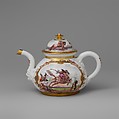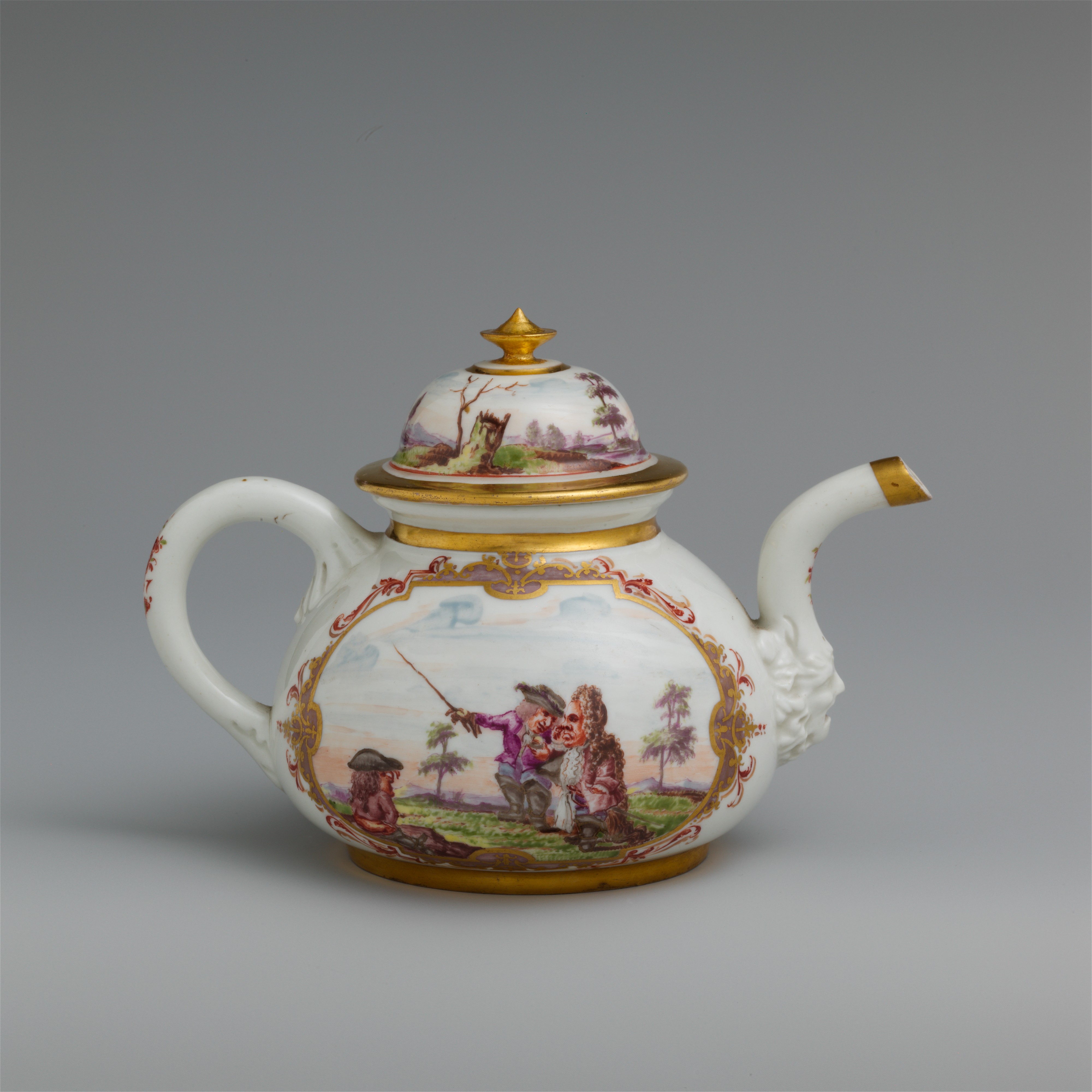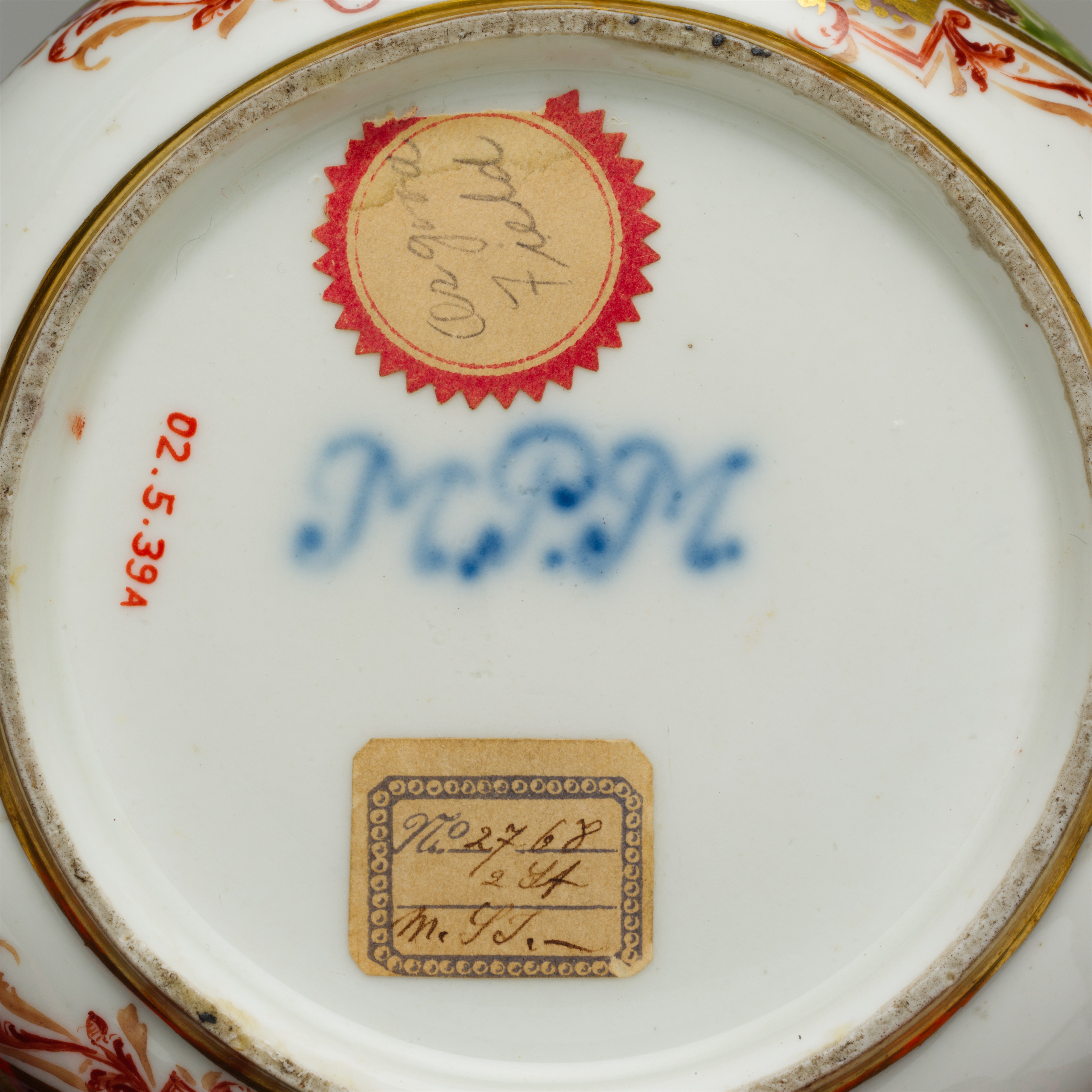Teapot with equestrian scene
Manufactory Meissen Manufactory German
Remarkably, the Meissen factory was producing porcelain on a commercial basis within three years of its founding in 1710 (entry 12). The artistic quality of its wares and decorative objects was impressively high from the outset, but throughout the 1710s, Meissen lacked the ability to successfully decorate its production with enamel colors. The Chinese and Japanese porcelains avidly collected by August II (1670–1733), commonly known as Augustus the Strong, elector of Saxony, king of Poland, during these years were notable for the superlative quality of their painted decoration, making the absence of brilliant enamel colors on the factory’s porcelain perceived as a serious deficiency. While Meissen had not yet mastered this technology, the wares and vases intended for painted decoration were delivered to Georg Funcke (German, active 1713–27), an independent enameler and gilder in Dresden. The porcelains painted by Funcke are prized today, both for their rarity and for their early date of production, but the enamels that he employed were limited both in range and in saturation, and so- called Funcke decoration is always modest in ambition.[1]
However, the arrival of German enameler Johann Gregorius Höroldt (1696–1775) at Meissen in May 1720 changed the factory’s capabilities in porcelain painting dramatically. Höroldt’s early years at Meissen have been extensively documented,[2] and his impact on every aspect of the factory’s production was far-reaching. In brief, Höroldt worked at the Du Paquier enterprise in Vienna (entry 28) prior to arriving at Meissen, and he brought a level of proficiency to enamel painting that was unknown either at Meissen or in Dresden at that time. Höroldt’s abilities were not confined to his painting expertise; he oversaw the development of a range of enamel colors at Meissen that was unprecedented, and he created a factory style that ensured Meissen’s prestige during the first half of the eighteenth century. Due to the quality of the work produced and the painters who he employed, the factory’s models shifted from those dependent on low-relief decoration to those that provided a smooth surface to facilitate the enamel painting. Höroldt was also responsible for devising the decorative scheme that defined Meissen porcelain for the next several decades: miniature scenes painted within an elaborate cartouche, an ornamental frame consisting of scrolling motifs executed in red or purple enamel, gilding, and sometimes with a distinctive pale-purple luster.
Before becoming officially employed by Meissen, Höroldt worked as an independent contractor for the factory for eleven years, and he assembled a team of painters who were paid by him rather than by the factory. Höroldt signed very few works, and it is difficult to attribute work to his hand with certainty, particularly since he was so influential in establishing a factory painting style. It is not known who painted the Museum’s teapot, but it is one of the earliest works with enamel decoration made at Meissen. The under-side of the teapot is marked M.P.M. (Meissener Porzellan Manufaktur), a mark that appears to have been in use only for a few months in autumn 1722, although the decoration may have been applied during the course of the following year.[3] At this time, the range of enamels was still in development, and the slightly muddy and muted colors on the teapot’s scenes attest to its early date. Höroldt is best known for the chinoiserie scenes that he both painted and promoted as a principal category of decoration in the 1720s, but some of the earliest compositions painted under his direction depict European subject matter.
The two reserves, as well as the lid of the Museum’s teapot, depict dwarfs at a riding school, and all of the figures are taken from a series of prints about a riding school for dwarfs, entitled Neu aufgerichte Zwergen-Reut-Schul eröffnet von N.E (fig. 28).[4] The teapot is part of a group consisting of three additional teapots, four sugar boxes, and one waste bowl (for used tea leaves), all of which have similar decoration that derives, with one exception, from this series.[5] This seemingly unlikely subject matter for porcelain decoration is less surprising than it might seem, as satirical prints depicting dwarfs were popular and widely circulated in the first quarter of the eighteenth century,[6] and the fascination with dwarfs extends back to the sixteenth century (entry 50). One side of the Museum’s teapot portrays a pupil riding a horse and shooting at a sculpture of a Turk’s head, knocking it off its pedestal. The explosion from the pupil’s gun, a wheel-lock blunderbuss, is mirrored by an explosion from the rear of the horse that knocks over two stableboys. The teapot’s other side depicts two standing figures, who may represent the school’s owner and a prospective client, with a seated stableboy on the left. The costumes and exaggerated wigs of the figures add to the satirical quality of the subject matter, and T. H. Clarke has suggested that the series of prints from which the compositions derive may have been intended as a humorous commentary on the follies of the nouveau riche.[7]
Rainer Rückert has observed that the bawdy and slightly vulgar nature of the painted decoration on this group is curiously at odds with the sophistication of the form, which can be attributed to Johann Jacob Irminger (German, 1635–1724), the court goldsmith who supplied designs for the factory’s models during the 1710s and early 1720s. This shape of teapot, with its bulbous body, ear-shaped handle, curved spout springing from a lower relief mask, and a high-domed cover, has its origins in a red- stoneware version made at Meissen from 1710 to 1713.[8] This model, with slight variations, was then produced in so-called Böttger porcelain, and very early examples—produced prior to the use of enamels at the factory—remain in the Porzellansammlung, Staatliche Kunstsammlungen Dresden.[9] Several more examples of this model exist with the same rare factory mark of M.P.M.,[10] indicating a date of production in 1722, and the form was used frequently for Höroldt-inspired chinoiserie decoration that came to prominence beginning in 1723.[11]
Footnotes
(For key to shortened references see bibliography in Munger, European Porcelain in the Metropolitan Museum of Art. NY: The Metropolitan Museum of Art, 2018)
1 See, for example, Cassidy- Geiger 2008, p. 342,
no. 112.
2 Walcha 1981, pp. 48–60; I. Menzhausen 1990,
pp. 15–18; Pietsch 1996a, pp. 7–22; Pietsch 2010b,
pp. 17–21; Nelson 2013, pp. 131–34.
3 Rückert 1966, p. 38; T. H. Clarke 1988, p. 8.
4 T. H. Clarke 1988, p. 8.
5 Ibid. This article discusses the group in depth, as well as the sources of decoration, and specifies which prints served as sources for the painter at Meissen.
6 Ibid., p. 6.
7 Ibid., p. 8.
8 Rückert 1966, p. 53, no. 3, pl. 2.
9 Walcha 1981, p. 452, pl. 32; I. Menzhausen 1990, p. 196, pl. 29.
10 Cassidy- Geiger 2008, p. 343, no. 113; Pietsch 2011, p. 131, no. 102; Nelson 2013, p. 441, no. 21.
11 See, for example, Pietsch 1996a, p. 82, no. 59, ill. p. 83.
Due to rights restrictions, this image cannot be enlarged, viewed at full screen, or downloaded.
This artwork is meant to be viewed from right to left. Scroll left to view more.




